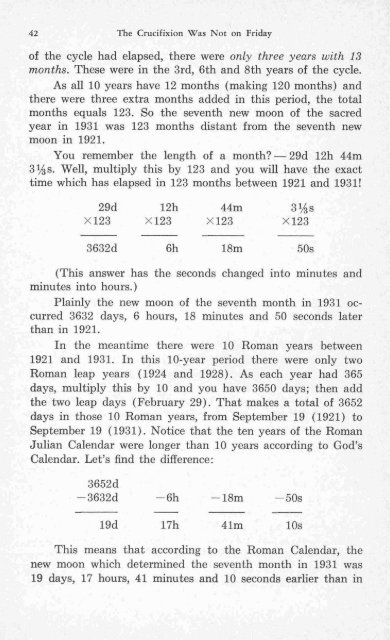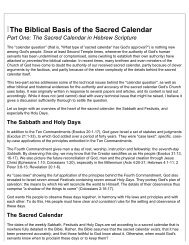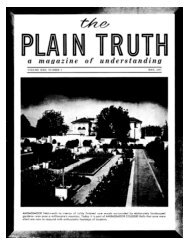The Crucifixion Was Not on Friday - Church of God Faithful Flock
The Crucifixion Was Not on Friday - Church of God Faithful Flock
The Crucifixion Was Not on Friday - Church of God Faithful Flock
Create successful ePaper yourself
Turn your PDF publications into a flip-book with our unique Google optimized e-Paper software.
42 <str<strong>on</strong>g>The</str<strong>on</strong>g> <str<strong>on</strong>g>Crucifixi<strong>on</strong></str<strong>on</strong>g> <str<strong>on</strong>g>Was</str<strong>on</strong>g> <str<strong>on</strong>g>Not</str<strong>on</strong>g> <strong>on</strong> <strong>Friday</strong><br />
<strong>of</strong> the cycle had elapsed, there were <strong>on</strong>ly three years with 13<br />
m<strong>on</strong>ths. <str<strong>on</strong>g>The</str<strong>on</strong>g>se were in the 3rd, 6th and 8th years <strong>of</strong> the cycle.<br />
As all 10 years have 12 m<strong>on</strong>ths (making 120 m<strong>on</strong>ths) and<br />
there were three extra m<strong>on</strong>ths added in this period, the total<br />
m<strong>on</strong>ths equals 123. So the seventh new mo<strong>on</strong> <strong>of</strong> the sacred<br />
year in 1931 was 123 m<strong>on</strong>ths distant from the seventh new<br />
mo<strong>on</strong> in 1921.<br />
You remember the length <strong>of</strong> a m<strong>on</strong>th?-29d 12h 44m<br />
3%~. Well, multiply this by 123 and you will have the exact<br />
time which has elapsed in 123 m<strong>on</strong>ths between 1921 and 1931!<br />
29d 12h 44m 3%s<br />
X 123 X 123 X 123 X 123<br />
3632d 6h 18m 50s<br />
(This answer has the sec<strong>on</strong>ds changed into minutes and<br />
minutes into hours.)<br />
Plainly the new mo<strong>on</strong> <strong>of</strong> the seventh m<strong>on</strong>th in 1931 occurred<br />
3632 days, 6 hours, 18 minutes and 50 sec<strong>on</strong>ds later<br />
than in 1921.<br />
In the meantime there were 10 Roman years between<br />
1921 and 1931. In this 10-year period there were <strong>on</strong>ly two<br />
Roman leap years (1924 and 1928). As each year had 365<br />
days, multiply this by 10 and you have 3650 days; then add<br />
the two leap days (February 29). That makes a total <strong>of</strong> 3652<br />
days in those 10 Roman years, from September 19 (1921) to<br />
September 19 (1931). <str<strong>on</strong>g>Not</str<strong>on</strong>g>ice that the ten years <strong>of</strong> the Roman<br />
Julian Calendar were l<strong>on</strong>ger than 10 years according to <strong>God</strong>’s<br />
Calendar. Let’s find the difference:<br />
3652d<br />
-3632d - 6h - 18m - 50s<br />
19d 17h 4 lm 10s<br />
This means that according to the Roman Calendar, the<br />
new mo<strong>on</strong> which determined the seventh m<strong>on</strong>th in 1931 was<br />
19 days, 17 hours, 41 minutes and 10 sec<strong>on</strong>ds earlier than in
















